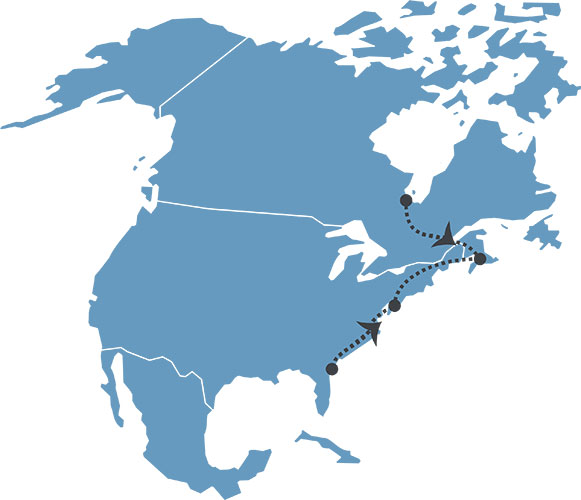Linking Sites, Linking Communities
Atlantic Flyway Exchange
In the Atlantic flyway, the exchange focused on three components – festivals, research, and managing human disturbance of roosting and feeding shorebirds.
In May 2017, four representatives from Dorchester, New Brunswick, Canada (Bay of Fundy WHSRN site), took part in a site exchange, participating in two festivals and meeting with local partners and community leaders. The site representatives’ goal was to use their Delaware Bay experience to build on and expand their Dorchester Shorebird Festival, which celebrates the shorebirds that stopover in the Bay of Fundy during fall migration. During the exchange, representatives were also able to learn about the other community engagement activities in the region, sparking additional ideas.

In 2018, representatives from the Georgia Barrier Islands and Delaware Bay then traveled to the Bay of Fundy to participate in the Dorchester Shorebird Festival and learn about the Bird Studies Canada’s Space to Roost program that manages disturbance on key roosting beaches. Disturbance from intense summer recreational pressures poses serious risks for shorebirds, as they have only a short period to build adequate energy reserves to complete their long migration. The work carried out at these vital shorebird sites will help develop effective conservation strategies and will improve communications with recreational users, advancing the goal of fostering long-term shorebird stewardship.
In May 2017 and 2018, banding exchange included the participation of Moose Cree First Nation representatives from James Bay, Ontario, Canada, and one US Fish and Wildlife Service (USFWS) representative from Portland, Oregon. The Moose Cree First Nation (MCFN) stewards a critical stopover site for migrating shorebirds on its homelands—the proposed James Bay WHSRN site. This site exchange was an opportunity for MCFN community leaders to experience conservation efforts in other places along the North American Atlantic flyway, in order to increase their capacity to support James Bay activities. The USFWS representative was focused on learning more about bird banding in order to expand it at the recently dedicated Willapa Bay WHSRN site in Washington, United States.
Sites in this Exchange
James Bay
Ontario, Canada
The aim at this project site was to establish a Western Hemisphere Shorebird Reserve Network (WHSRN) Site of Hemispheric Importance along the southern James […]
Bay of Fundy
New Brunswick and Nova Scotia, Canada
The food-rich mudflats of the Bay of Fundy annually support nearly 30% of the world’s population of Semipalmated Sandpipers, in […]
Delaware Bay
Delaware and New Jersey, USA
In May, hundreds of thousands of shorebirds stop at Delaware Bay to rest and to refuel on horseshoe crab eggs before their long journey to the Arctic[…]
Georgia Barrier Coast
Georgia, USA
A series of islands along Georgia’s 160-km (100-mile) coast provides critical foraging, resting and wintering habitat for over 20 species of shorebirds[…]

Produced with support from the Commission for Environmental Cooperation – www.cec.org
The Commission for Environmental Cooperation (CEC) is an intergovernmental organization that supports the cooperative environmental agenda of Canada, Mexico and the United States to green North America’s economy, address climate change by promoting a low-carbon economy, and protect North America’s environment and the health of its citizens.
To foster North American conservation opportunities for Semipalmated Sandpipers (Calidris pusilla) and Red Knots (Calidris canutus—rufa and roselaari subspecies), the Commission for Environmental Cooperation (CEC) started an initiative to inform, engage and connect communities at key sites for these two species. This included linking sites in the Pacific flyway and the Atlantic flyway.




